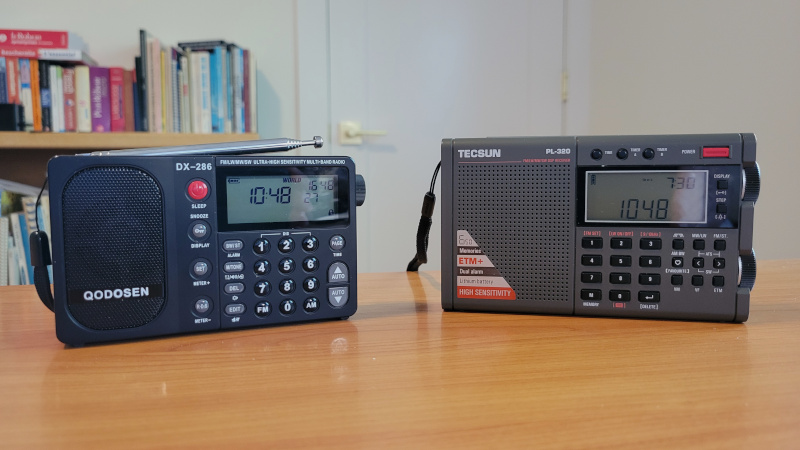
Introduction
After the first generation of DSP-based radios appeared in the first decade of the 2000s, especially with drastic improvements to FM reception quality, the lineup of the best models didn't change all that much. In 2023 and 2024, Tecsun and a new manufacturer, Qodosen, brought out models (right) that squeezed out even better performance from DSP designs, as well as remediating noise and other issues that could afflict AM reception on such radios.
Coincidentally, in 2023, I moved from the San Francisco Bay Area to Denver, Colorado. I wanted to see how radios stacked up in my new location. To do that, I needed to refine my methodology for evaluating radios. In the Bay Area, I simply counted the number of stations that could be received. At my location in Oakland, if I got a readable signal, it could be considered evidence that the radio could pick up a station.
Denver offers a greater variety of reception conditions. On FM, some of this is due to the location of many translators (low-power repeaters) on Lookout Mountain west of the city. Reception of such stations starts to fizzle out in downtown area and in areas to the east.
On AM, reception is possible from stations in multiple cities along the Front Range. This, too, offers a greater variety of reception quality. Thus, I needed to develop a method that was better than just tallying station counts.
Methodology
The methodology used in this evaluation attempts to combine tallying station counts with a judgment about the signal quality from each station received. This is still not a truly qualitative method. While DSP radios have signal-strength meters, they are not calibrated to a common standard. As a consequence, I can't rely on them. The result is a method of qualitative evaluation that masquerades as a quantitative evaluation. It's important to understand this limitation, because it introduces some variability into results. It also means you have to trust my ears and my judgment. I hope what amounts to my opinion is backed up by actual results, but I can offer no guarantees.
In any event, I believe this methodology is sufficient to meet the objective of ranking the radios in head-to-head comparisons, though it could probably be improved.
I first created a list of all the stations that have been received on any radio at my location. Separate lists are used for AM and FM.
Next, I created a scoring system for each band. I scored each station received as follows:
- 5 - Noise-free, strong local signal
- 4 - Slight noise levels, strong signal
- 3 - Moderate noise, moderate strength; still tolerable for most people
- 2 - Higher noise levels, programming still audible
- 1 - High noise levels, programming audible; most people wouldn't put up with it
- 0.5 - Trace of a signal only, not really listenable
Also on FM, a radio receiving a station broadcasting in stereo must receive it in stereo; otherwise, its maximum score for that station will be 3. This requires knowing that station is or isn't broadcasting in stereo, which is easy enough to figure out for even a signal of just moderate strength.
After listening, I sum up the scores, with the highest scores representing the best performance. Sensitivity naturally is emphasized by this approach, though selectivity also is represented, particularly for weaker signals.
I would like to find an approach that normalizes these scores for a better-quality comparison. But I haven't been able to do that so far. My understanding of statistics and probability came "on the job" over decades of risk management. If I understood the theory better, I might be able to find a better approach. If you have any insights or suggestions for a better approach, please let me know; here's my contact information.
Another factor that can affect the results is the on-air status of stations in the Denver area. For example, scores for all AM receivers went down in the December 2024 and February 2025 evaluations because KPLS(AM), a strong local station for which all receivers should get a score of 5, was off the air. If a station is off the air, the weighted score will be lowered proportionally to the score that a receiver usually will get for it. These types of variations can average out, but I haven't found averages to be useful in comparing radios.
Conditions for evaluations
I try to conduct evaluations with a reasonably well-defined set of conditions. For AM radios:
- I use an audio bandwidth of 3 kHz where available.
- I use only internal ferrite antennas, also known as "barefoot" operation.
- I conduct the evaluation in the early afternoon hours when any skywave effects are likely to be absent.
For FM:
- I conduct the evaluation in the early afternoon hours where any tropospheric enhancement should be at its least.
- I conduct the evaluation at ground level.
- I use only the telescoping antenna provided by the radio, even if it's the incorrect length for FM reception (most are).
- I do not use an antenna extender or any sort of external antenna.
DSP-based radios (most are pictured below) compared in the AM and FM evaluations were:
First photo:
- Qodosen DX-286
- Tecsun PL-320
- Tecsun PL-380
- Digitech AR-1780 (not pictured; I couldn't fit it in even with a wide-angle lens)
The Digitech AR-1780 was an Australian model. Other than its appearance and the use of AA batteries rather than lithium-ion batteries, it was identical to the first version of the XHDATA D-808. Radio Jay Allen has more on the different versions of the XHDATA or Sihuadon D-808.
Next photo:
- Tecsun PL-310ET
- C. Crane Skywave (AM comparison only)
- Grundig G8 (AM comparison only)
All radios except the Qodosen use one of the Silicon Labs DSP receiver chips; the Qodosen uses the NXP TEF6686 chip more commonly found in motor vehicles.
I conducted a second set of evaluations, for both AM and FM, on December 21, 2024. This time, instead of the Digitech AR-1780, I used a newly acquired XHDATA D-109WB (not pictured here) for the evaluation.
On February 24, 2025, I conducted yet another evaluation after acquiring the Lijiani RD239 radio and media player-recorder. The other radios evaluated in that round were:
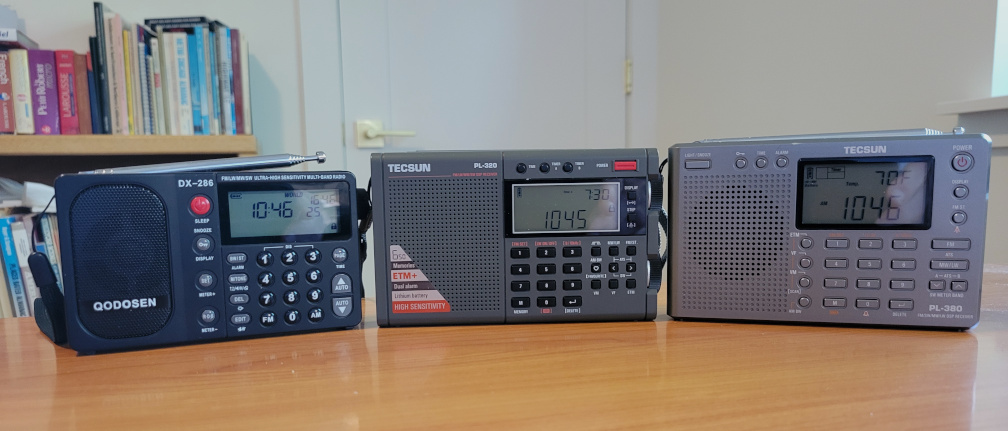
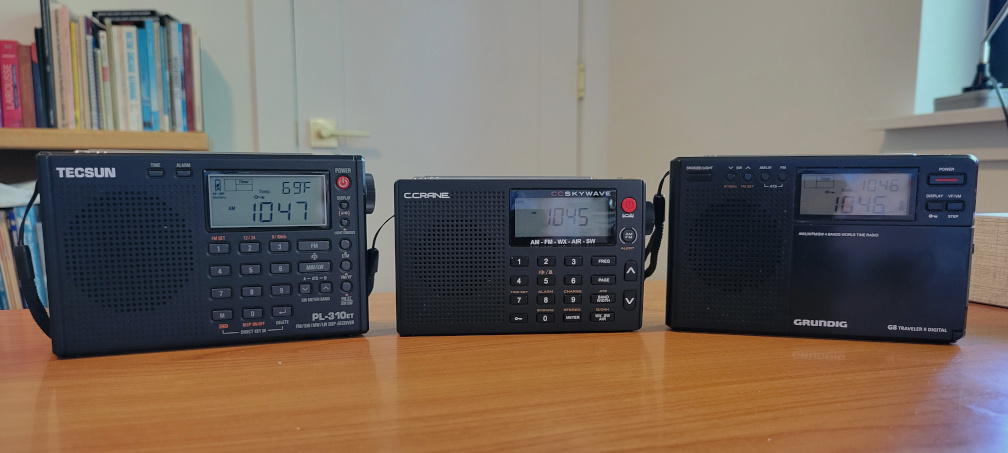
FM evaluation
The original FM evaluation was conducted August 20, 2024, on a fairly typical warm and dry summer day in Denver.
Details are in this spreadsheet-generated PDF. Summarizing the results by total weighted score:
- Qodosen DX-286: 202
- Tecsun PL-320: 199
- Tecsun PL-380: 190
- Tecsun PL-310ET: 188
- Digitech AR-1780: 187
I had considered the Tecsun PL-380 to be my best FM radio. After this evaluation, the Qodosen DX-286 was the new champion, with the Tecsun PL-320 close behind. My conclusion from these results was that FM reception has gotten even better with the newer generation of DSP-based radios.
I conducted a second set of evaluations on December 21, 2024, an unusually warm winter day in Denver, so I was able to perform the comparisons outside. This time, instead of the Digitech AR-1780, I used a newly acquired XHDATA D-109WB for the evaluation. My conclusions from the first evaluation aren't changed, though the Qodosen did exceptionally well this time.
Details are in this spreadsheet-generated PDF. Summarizing the results by total weighted score:
- Qodosen DX-286: 216
- Tecsun PL-320: 208.5
- Tecsun PL-380: 203
- Tecsun PL-310ET: 206.5
- XHDATA D-109WB: 200.5
After acquiring the Lijiani RD239 AM/FM/weather band, etc. radio and media player/recorder early in 2025, I conducted a head-to-head comparison of the new radio with some of the radios in previous evaluations on February 24, 2025. It was an unusually warm winter day, so the evaluation was conducted outside. For radios that had been in previous evaluations, the results were somewhat similar. As for the Lijiani, the numbers tell the tale:
- Qodosen DX-286: 220
- Tecsun PL-320: 206.5
- Tecsun PL-380: 198.5
- XHDATA D-109WB: 203
- Lijiani RD239: 141.5
The Lijiani was an inferior FM performer. A substantial number of stations that could be received clearly on other radios were swamped by noise on the Lijiani. I had high hopes for this radio, especially for its recording capabilities, but I found the FM reception really wasn't good enough to do that with any but the strongest signals.
Details of this evaluation are in its own spreadsheet-generated PDF.
AM evaluation
The first AM evaluation was conducted August 24, 2024, another warm and dry day with lots of sunshine in Denver. There were no thunderstorms in the vicinity.
Details are in this spreadsheet-generated PDF. Summarizing the results by total weighted score:
- Tecsun PL-320: 158
- Digitech AR-1780: 157
- C. Crane Skywave: 150
- Qodosen DX-286: 150
- Tecsun PL-380: 145.5
- Grundig G8: 144.5
- Tecsun PL-310ET: 144
I wasn't surprised by the Digitech's strong performance. It's larger than these other radios and has a larger internal ferrite antenna. I was surprised that the Tecsun PL-320 came out on top. It does have an unusually aggressive automatic gain control, which actually sounds rather unpleasant when tuning around for stations. But that AGC also appears to help the PL-320 pull signals out of the background noise that infests the AM band to an ever-great extent. That said, the PL-320 also seems to pull up more noise on vacant AM channels. It isn't as refined or pleasant to use on AM as the Qodosen or Digitech models.
Also note that the PL-320 did not have a 3 kHz bandwidth filter available. I decided that a 3.5 kHz bandwidth was most suitable for this comparison.
The Digitech AR-1780 was the quietest receiver, with the least noise on empty channels.
The C. Crane was a first-generation receiver; C. Crane has since made some improvements in the model. It's possible the newer version Skywave would have performed slightly better. (See Radio Jay Allen for a more informed perspective.) It still did pretty well in this evaluation. The Qodosen DX-286 tied with the C. Crane for third place in this comparison.
The first-generation Tecsun DSP radios weren't quite as strong performers as the others. This includes the Grundig G8, which was made by Tecsun. Tecsun also sold the model as the PL-300WT. These units have been prone to interference generated by the radio itself due to inadequate internal filtering of noises from the internal digital circuitry.
After acquiring an XHDATA D-109WB radio, I conducted another evaluation on December 21, 2024. Because it was an unusually warm day in Denver, I was able to conduct the evaluation outside, avoiding interference from electronics and other household sources of interference. The XHDATA radio held its own with the older-generation DSP receivers, but the newer Tecsun PL-320 and Qodosen DX-286 still were just a little more sensitive.
Details are in this spreadsheet-generated PDF. Summarizing the results by total weighted score:- Qodosen DX-286: 145.5
- Tecsun PL-320: 145
- Tecsun PL-310ET: 140.5
- Tecsun PL-380: 140
- XHDATA D-109WB: 140
A cautionary note: this comparison was done between 2:30 and 3:30 pm on one of the shortest days of the year. By 3:30 pm, I was already detecting skywave propagation at 1500 kHz and above. In Denver, the portion of the AM band from 1500 to 1590 kHz has only weak stations (except for strong local KPLS, which was off the air that day), so I believe the effect on this evaluation's results are minor at worst.
The day before the December 21 evaluation, I tried an indoor evaluation, which showed that the performance of some of the radios was reduced by being indoors. The XHDATA D-109WB and Qodosen DX-286, though, did not seem to be much affected. To avoid cluttering this review with even more data, I'll just summarize the results by total weighted score.
- Qodosen DX-286: 144.5
- XHDATA D-109WB: 140
- Tecsun PL-320: 136.5
- Tecsun PL-310ET: 129
I did not test the Tecsun PL-380 in the December 20 comparison, but I anticipate its performance would have been similar to the Tecsun PL-310ET since both radios have otherwise been shown to perform nearly the same.
Early in 2025, I acquired the Lijiani RD239 radio and media player/recorder. On February 24, another warm winter day, I conducted a comparison with four other models, using the same methodology as the other head-to-head comparisons.
- Tecsun PL-320: 153
- Qodosen DX-286: 150
- Tecsun PL-380: 140
- XHDATA D-109WB: 140
- Lijiani RD239: 130
The variations in results for the Tecsun PL-320 are a little surprising, but conditions can vary from day to day. As with most of the other comparisons, it appears that the Tecsun PL-320 and the Qodosen DX-286 are in a class by themselves. The Lijiani is still a decent AM performer, but isn't quite in the same league as the others.
Details of this test are in its own spreadsheet-generated PDF.
AM comparisons with the Sony SRF-A100
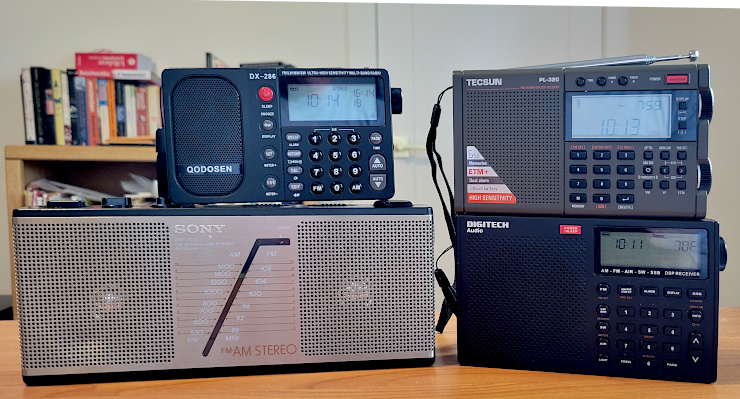
About a month after the first series of tests in July 2024, I decided to see how the better DSP-based performers stack up again the classic AM stereo receiver from the 1980s (left), the Sony SRF-A100. Of course, AM stereo is now scarce, so that wasn't the purpose of this test. As an AM radio, the SRF-A100 is excellent. It has two bandwidth settings, which was unusual for its time, and very good sensitivity. I thought it could be a worthy competitor to the newest generation of DSP-based radios. The Sony, in its wide bandwidth mode, has very good audio fidelity, limited nowadays by subsequent regulations requiring AM stations to limit their top frequency response to 10 kHz.
Details of this test are in its own spreadsheet-generated PDF. Results for the DSP radio will differ from those in the previous AM comparison because the SRF-A100 doesn't tune the entire expanded AM band. Thus the SRF-A100 was unable to tune to a local station at 1690 kHz. For a fair comparison, I did not count reception of that station for the receivers that were able to tune to that frequency. To summarize the results by total weighted score:
- Tecsun PL-320: 154
- Digitech AR-1780: 153
- Sony SRF-A100, narrow bandwidth: 149
- Qodosen DX-286: 146
- Sony SRF-A100, wide bandwidth: 135
The older analog design of the SRF-A100 was clearly very well done. At the narrow bandwidth setting, it was almost as good as the Tecsun PL-320 or the Digitech AR-1780. The wide bandwidth setting comes at a tradeoff with selectivity, resulting in fewer weak stations received. Still, it's interesting to see how good the SRF-A100 is against tougher modern competition, not to mention a noisier AM band.
Most of the DSP-based radios cost between $50 and $90. I don't remember precisely, but I think I paid around $50 for the SRF-A100 in 1984. Forty years later, that would have been a cost of more than $150. This shows that better performance is now available at a lower price level than ever before. Too bad that radio stations are suffering economically, causing programming to be more cautious and less interesting. There's something magical about pulling tiny voltages out of the air and turning them into sound. One hopes future generations will have the opportunity to experience that feeling.
FM comparisons with the NAD 4300 performance tuner
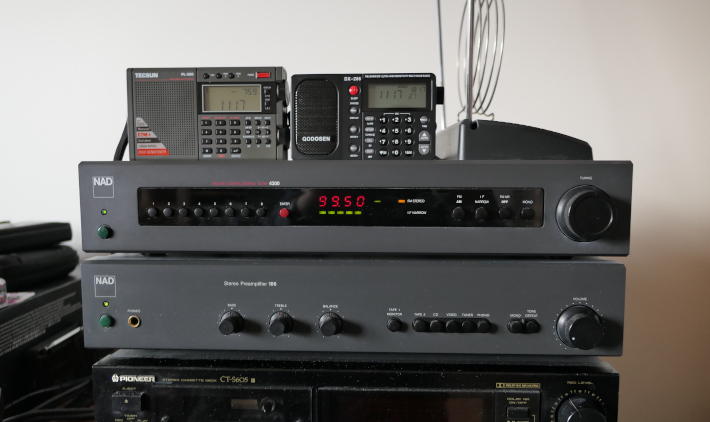
Since I bought it in 1990, I've considered the NAD 4300 component tuner to be the most sensitive one I have. It has two bandwidths, so it can be made more selective as needed. The audio quality will, of course, depend upon the station that you're listening to. If the station is broadcasting high-quality audio, the NAD 4300 will let you hear the quality. Unfortunately, most stations broadcast lower-quality audio to sound "loud" or to encode information used by ratings services.
Still, I was curious as to how the NAD 4300 would stack up to today's high-performance DSP radios. I decided to focus only on FM; the NAD 4300's AM section is fairly decent for its time but it has to be plugged into AC power, which makes it more prone to picking up interference compared to a battery-powered radio. So a comparison of the NAD 4300 tuner to battery-powered radios could be unfair.
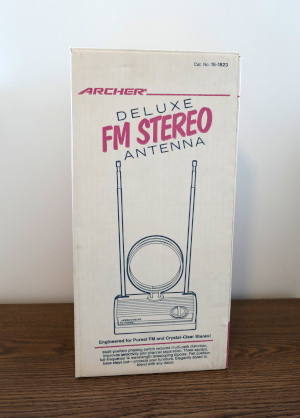
I selected two DSP radios for this comparison, the Qodosen DX-286 from 2024 and the Tecsun PL-320 from 2023. An important feature of these radios is their support of an external antenna. Thus, with an adapter, I could connect the Radio Shack rabbit-ears antenna (box at right) that I use for the NAD 4300 to the newer radios as well. I believe this made for a fairer comparison.
The test was performed the day after Christmas on the second floor of my home between 10:15 and 11:15 am, give or take a few minutes. There appeared to be a little tropospheric enhancement of reception during part of that time, tapering off when getting closer to midday. This resulted in some interference to a few translators from more powerful stations in Colorado Springs. I tried to compensate by re-checking stations at those frequencies later in the evaluation.
I consider both selectivity and sensitivity in these evalutions, so I will note that, on the NAD 4300, I used whichever bandwidth setting gave the best results; on the Qodosen DX-286, I used the automatic bandwidth setting. The Tecsun PL-320 doesn't provide user control of FM bandwidth but generally is quite selective.
The results of this evaluation, using the same scoring method that I've used for other evaluations in Denver:
- Tecsun PL-320: 221
- Qodosen DX-286: 220.5
- NAD 4300: 213
Three things stand out about these results:
The raw scores are higher than for any other evaluations. The tropospheric enhancement that I referred to earlier is probably a minor factor at most. More important are the use of a higher-gain rabbit-ears antenna and a higher reception location (eight or nine feet higher) than other evaluations. In retrospect, I should have included a first-generation DSP radio to see how it would have fared under these circumstances.
The NAD 4300 was selective, but modern FM reception conditions can be particularly difficult due to lowered technical standards. In my part of Denver, there's a train wreck of reception conditions at one slice of the dial: translators at 93.7 and 94.1 MHz, a low-power FM at 93.9 MHz, and fringe reception of KILO(FM) Colorado Springs at 94.3 MHz. Any radio that's from the 2000s or before will have trouble with this insane situation. I believe this hurt the NAD 4300's score, causing it to lose three or four points it otherwise would have had. That margin could have made the NAD 4300's performance more similar to the other radios. It's still an excellent result, but the newer radios handled this situation better.
The Qodosen DX-286 and Tecsun PL-320 were nearly equal in performance. Given variations in reception conditions over a given period, the Qodosen could have come out on top in another evaluation under similar conditions. I think it's safe to say that both radios perform beautifully and either one will give excellent results on FM.
I've considered the NAD 4300 to be my reference tuner, and I'm still going to listen to it with pleasure. That said, the Qodosen and Tecsun radios set a slightly higher standard for performance, particularly selectivity, at a much lower cost than I originally paid for the 4300!
More on the performance comparisons
» Spreadsheet for AM comparisons among DSP radios, December 2024
» Spreadsheet for AM comparisons among DSP radios, including the Lijiani RD239, February 2025
» Spreadsheet for AM comparisons with the Sony SRF-A100, September 2024
» Spreadsheet for FM comparisons among DSP radios, August 2024
» Spreadsheet for FM comparisons among DSP radios, December 2024
» Spreadsheet for FM comparisons among DSP radios, including the Lijiani RD239, February 2025
» Spreadsheet for FM comparisons between the NAD 4300 performance tuner from the 1990s and the top-performing DSP radios, the Qodosen DX-286 and the Tecsun PL-320, December 2024